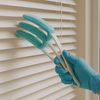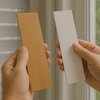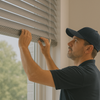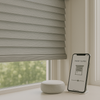Expert Installation Tips from a 15-Year Window Treatment Professional
- by Mariam Labadze
Quick Answer
Professional blind installation success requires accurate measurement (measure three times at different points accounting for irregularities), proper tools (quality cordless drill, level, stud finder, sharp pencil), and understanding window types. Measure width and height at three positions using smallest dimensions for recess fits, adding 10-15cm each side for face-fix mounting. Mark bracket positions precisely using a level, pre-drill pilot holes preventing frame damage, and test operation before final tightening. Common mistakes include single-point measuring, ignoring wall construction when selecting fixings, and rushing installation. Professional-quality results demand patience, proper preparation, and systematic approaches that DIYers can master through careful attention to these expert techniques refined over 15 years installing thousands of window treatments.
Measurement: Where Most Installations Fail
The Three-Point Rule – Never measure windows at single points. UK windows, particularly in older properties, rarely feature perfect right angles or consistent dimensions. Measure width at top, middle, and bottom positions, then height at left, center, and right. Record all six measurements—discrepancies reveal window irregularities affecting installation.
For recess mounting, use the smallest width and height measurements ensuring blinds fit within the tightest points without binding. Attempting to fit blinds sized for widest points creates operational problems when they reach narrower sections during use.
Face-fix mounting requires measuring the area you want covering—typically adding 10-15cm beyond window frames on all sides for adequate light blocking and aesthetic proportions. These extensions also help concealing any gaps between frame edges and walls.
Depth Matters – Recess depth often gets overlooked until installation day reveals insufficient space. Measure from glass surface to where brackets will mount, ensuring adequate clearance for blind mechanisms, fabric rolls, or slat stacks. Minimum depths vary by blind type: rollers need 4-5cm, venetians require 6-8cm, whilst cellular designs might demand 8-10cm.
Protruding window handles, locks, or tiles commonly interfere with recessed installations. Identify these obstructions during measuring, not during installation when discovering problems wastes time and creates frustration. Sometimes face-fix mounting proves the only viable solution despite recess preferences.
Write Everything Down – Professional installers use detailed measurement sheets recording every dimension, noting obstacles, photographing installation areas, and sketching unusual configurations. This documentation prevents confusion when ordering multiple windows or returning to sites after measurement appointments. Create similar records for your own installations—memory proves unreliable when managing complex projects.
Essential Tools for Quality Installation
Power Drill – Quality cordless drills with adjustable clutch settings prevent over-tightening that strips screw heads or cracks frames. Variable speed control allows starting holes gently without drill bits skating across surfaces. Invest in decent tools—cheap drills lack power for masonry work and lack finesse for delicate frame materials.
Drill Bits – Match bits to wall construction. Masonry bits for brick/concrete, wood bits for timber frames, and metal bits for steel frames. Using wrong bits damages materials, dulls bits rapidly, and creates poorly sized holes compromising fixing strength. Quality bit sets covering all common materials cost £20-£30 but prove invaluable across numerous projects.
Spirit Level – Wonky blinds appear unprofessional and may operate poorly. Use quality levels—cheap plastic versions provide unreliable readings creating crooked installations. Laser levels simplify marking multiple bracket positions consistently, particularly valuable when installing numerous windows requiring coordinated heights.
Stud Finder – Electronic stud finders prevent accidentally drilling into hidden pipes or electrical cables that could cause expensive damage or dangerous situations. Spend £25-£40 on reliable detectors rather than risking catastrophic mistakes that cheap or absent detection creates.
Measuring Tools – Steel measuring tapes maintain accuracy better than cloth versions that stretch over time. For large windows, laser measurers provide instant precise readings without juggling unwieldy tape measures alone.
Pencils and Marking – Sharp pencils create precise marks that thick marker pens cannot match. Mark mounting points exactly—a 2mm error becomes 4mm across paired brackets, creating enough misalignment causing operational problems or visually obvious wonkiness.
Understanding Wall and Frame Construction
uPVC Frames – Modern plastic frames require careful drilling avoiding excessive pressure that cracks material. Pilot holes slightly smaller than screw diameters create proper threads, whilst oversized holes allow screws spinning uselessly without gripping. Use short screws (25-30mm maximum) avoiding penetrating completely through frames into cavities beyond.
Some uPVC frames contain metal reinforcement that drill bits encounter unexpectedly. If drilling becomes suddenly difficult partway through, you've likely hit steel. Switch to metal bits completing holes properly rather than forcing wood bits that overheat and fail.
Timber Frames – Older properties feature wooden frames accepting screws readily but prone to splitting if holes are drilled too close to edges or without pilot holes. Position brackets minimum 15mm from frame edges, pre-drill all holes, and use appropriate screw lengths avoiding penetrating completely through and damaging interior surfaces.
Brick and Masonry – Face-fix mounting to brick or rendered walls requires masonry bits, appropriate wall plugs matching screw sizes, and understanding that crumbly old mortar provides poor fixing. When possible, drill into bricks rather than mortar joints for superior holding strength.
Hammer drills greatly ease masonry drilling, though excessive hammer action can crack plaster around holes. Use hammer function sparingly, allowing drill bit cutting through masonry rather than relying entirely on impact action.
Plasterboard Walls – Internal walls with plasterboard over stud frames require finding studs for secure mounting or using appropriate plasterboard fixings rated for blind weights. Toggle bolts or metal cavity anchors rated 10kg+ work for lightweight blinds, but finding studs remains preferable for substantial treatments.
Bracket Positioning and Installation
Measuring from Frame Edges – Manufacturers specify exact bracket positioning—typically 5-10cm from window edges with additional center supports for spans exceeding certain widths. Follow these specifications precisely. Arbitrary positioning creates uneven weight distribution causing mechanisms binding or fabric tracking poorly.
Use the level confirming both brackets sit at identical heights. Even 2-3mm differences create noticeably crooked appearances once blinds hang. Mark both bracket positions, then verify alignment before drilling permanent holes that cannot be undone if mistakes occur.
Pilot Holes Prevent Disasters – Always pre-drill pilot holes smaller than screw diameters. This simple step prevents wood splitting, reduces required driving force protecting frames from damage, and ensures screws track straight rather than veering off-course creating loose fixings.
For masonry, pilot holes guide wall plugs properly rather than allowing them wandering or crushing during insertion. Poorly seated plugs provide inadequate grip causing brackets pulling loose under operational stress or blind weight.
Test Fit Before Final Tightening – Install brackets loosely initially, hang blinds testing operation and alignment before fully tightening. This precaution allows adjustments if minor repositioning improves operation or appearance. Once screws tighten completely, adjustments become difficult without creating additional holes that weaken frames or appear unsightly.
Common Installation Mistakes to Avoid
Rushing Measurements – Taking five extra minutes during measuring prevents hours of frustration during installation. Verify every dimension, double-check calculations, and ensure understanding exact mounting locations before ordering blinds. Mistakes discovered after products arrive create expensive problems requiring returns, reorders, and delayed projects.
Wrong Fixings for Materials – Using wood screws in masonry or vice versa creates weak installations failing prematurely. Match fixings to materials being drilled—this basic principle prevents majority of installation failures that blamed products when actually installer error caused problems.
Ignoring Operating Clearances – Blinds need space operating properly without fabrics catching on handles, mechanisms contacting window sills, or controls interfering with adjacent furniture. Visualize full operation range before finalizing mounting positions preventing frustrating discoveries that blinds cannot fully open or close due to insufficient planning.
Over-Tightening Screws – Excessive force strips threads in frames, cracks uPVC, or breaks bracket mounting tabs. Tighten screws firmly but not brutally—when they stop advancing easily, that's sufficient. Additional force damages rather than improves fixings.
Single-Person Installation of Large Blinds – Heavy or wide treatments require two people—one steadying blinds whilst another secures brackets. Attempting solo installation of substantial treatments risks dropping blinds, misaligning brackets, or personal injury from awkward lifting positions.
Professional Finishing Touches
Cable Management – Cordless systems avoid this concern, but corded blinds benefit from neat cable routing. Use provided clips positioning chains or cords tidily rather than allowing them dangling haphazardly. These small details separate professional appearances from obviously amateur installations.
Operation Testing – Before considering jobs complete, test full operational range multiple times. Raise and lower blinds completely, adjust slats through full tilting range if applicable, and verify smooth operation without binding, jamming, or unusual resistance. Address any issues immediately whilst tools remain accessible and motivation remains high.
Final Adjustment – Step back viewing installations from normal room positions rather than close-up installation perspectives. Minor adjustments—shifting brackets millimeters, adjusting tension—that seem unnecessary close-up often prove valuable improving appearances from distances where you'll actually experience blinds daily.
Cleaning Up – Remove all packaging materials, vacuum drilling dust, wipe frame surfaces, and ensure rooms look better than before starting. Professional installers leave spaces cleaner than they found them—adopt this standard for personal projects creating pride in completed work.
When to Call Professionals
DIY saves money but recognizing situations exceeding skill levels prevents expensive mistakes. Very large windows, unusual shapes, bay configurations, or high installations requiring scaffolding often justify professional involvement. Premium expensive treatments warrant professional installation protecting investments through expert handling.
Complex motorization involving electrical work absolutely demands qualified electricians ensuring safe, code-compliant installations. Battery-powered systems remain DIY-friendly, but mains-powered motors require proper electrical expertise preventing dangerous installations or invalidating home insurance through non-compliant work.
At 1 Click Blinds, we offer both comprehensive DIY support and professional installation services throughout the UK. Whether you're confident tackling installations yourself with our expert guidance or prefer our experienced installers ensuring perfect results, we're committed to helping you achieving beautiful, functional window treatments enhancing your home for years.







